Musik, Ethnomusic
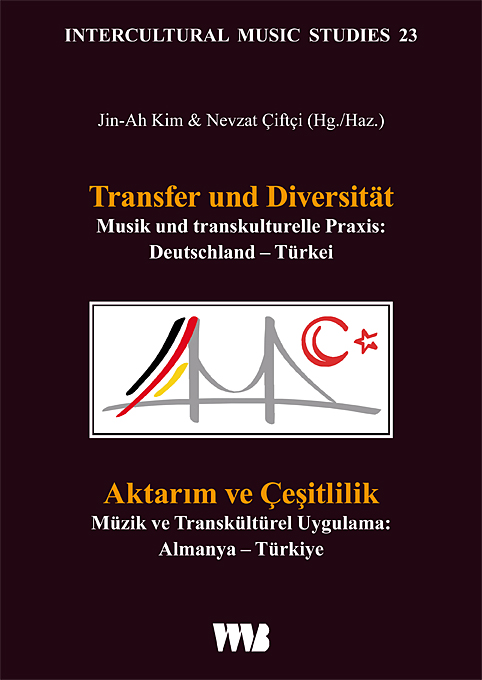
Transfer und Diversität. Musik und transkulturelle Praxis: Deutschland – Türkei — — — Aktarım ve Çeşitlilik. Müzik ve Transkültürel Uygulama: Almanya – Türkiye Jin-Ah Kim & Nevzat Çiftçi (Hg./Haz.) (Intercultural Music Studies Vol.: 23) 2020 368 S. zahlr. Abb. und Notenbeispiele Index Zusammengfassungen in deutsch, türkisch sowie in englischer Sprache 17 x 24 cm EUR 38,00 ISBN 978-3-86135-654-7 Die in diesem Band versammelten 17 Beiträge setzen sich mit dem Thema von Transfer und Diversität zur Musik in der wechselseitig transkulturellen Praxis zwischen Deutschland, der Türkei und Europa auseinander. Als Ausdruck einer länderübergreifenden Kooperation ist der Sammelband entsprechend zweisprachig gestaltet mit originären deutschen oder türkischen Artikeln, die zugleich mit Zusammenfassungen in der jeweils anderen Sprache versehen sind und auch je ein englisches Summary aufweisen. Die Beiträge erschließen ein Repertoire an Themen, Aspekten und methodischen Herangehensweisen in der Erforschung der deutsch-türkischen sowie globalen Verflechtungen. Über die territorialen Grenzen hinweg werden nationale, interkulturelle und transkulturelle Musikpraktiken in ihrer Geschichte und Gegenwart ausgelotet. Dies erfolgt sowohl auf theoretischer Ebene als auch anhand einzelner Fallbeispiele zu Musik, Migration, Ethnizität, zu Dichtersängern, Gender und interkultureller Lebenspraxis. * * * Bu ciltte bir araya getirilen 17 makale, Almanya, Türkiye ve Avrupa arasındaki karşılıklı transkültürel uygulamalar bağlamında müzikte aktarım ve çeşitlilik temasını ele alıyor. Bu kitap, ulusötesi işbirliğinin göstergesi olarak Türkçe ya da Almanca olarak yazılmış özgün makaleler ve özetler ile özetlerin Almanca ya da Türkçe çevirilerinin verilmesiyle iki dilli olarak oluşturuldu; ayrıca her makalenin İngilizce özeti de verildi. Makaleler, Almanya ve Türkiye arasındaki bağlantılar kadar küresel bağlantıların da araştırılmasında öne çıkan temalar, bakış açıları ve yöntemsel yaklaşımlardan oluşan bir dağarcığı erişime açıyor. Bölgesel sınırlar bir yana ulusal, kültürlerarası ve transkültürel müzik pratikleri, geçmişleri ve bugünleriyle derinlemesine araştırılıyor. Söz konusu araştırma, hem kuramsal düzlemde hem de müzik, göç, etnisite, âşıklar, toplumsal cinsiyet ve kültürlerarası yaşam pratikleri yardımıyla münferit vaka örnekleri üzerinden yapılıyor. Inhaltsverzeichnis / İçindekiler Jin-Ah Kim & Nevzat Çiftçi: Einleitung Jin-Ah Kim & Nevzat Çiftçi: Giriş Zum Gedenken an Prof. Dr. Şefika Şehvar Beşiroğlu (Center for Advanced Studies in Music der Technischen Universität Istanbul) Prof. Dr. Şefika Şehvar Beşiroğlu’nun Anısına (İstanbul Teknik Üniversitesi Müzik İleri Araştırmalar Merkezi) I. Transfer und Diversität: Konzepte und Perspektiven // Aktarım ve Çeşitlilik: Konseptler ve Perspektifler Jin-Ah Kim: Transfer und Diversität: Musik und transkulturelle Praxis (Aktarım ve Çeşitlilik: Müzik ve Transkültürel Uygulama) Wolfgang Welsch: Was ist eigentlich Transkulturalität? Und inwiefern gibt es sie auch in der Musik? (Transkültürellik Aslında Nedir? Ve Hangi Surette Müzikte de Vardır?) II. Transkulturelle Prozesse und musikalische Praktiken: Europa & Asien/Deutschland & Türkei // Transkültürel Süreçler ve Müzikal Uygulamalar: Avrupa & Asya/Almanya & Türkiye Max Peter Baumann: Zur Dynamik transkultureller Prozesse in der europäisch-deutsch-türkischen Begegnung (Avrupa-Alman-Türk Temaslarındaki Transkültürel Süreçlerin Dinamiğine Dair) Dorothea Kolland: Von der Gleichzeitigkeit des Ungleichzeitigen. Ethnische Traditionen oder postmigrantische Wege (Eş Zamanlı Olmayanın Eş Zamanlılığına Dair. Etnik Gelenekler veya Post-Göçmen Yollar) Alper Maral: Bon pour l’occident! Hem de Mutfağından, Taptaze (Bon pour l’occident! Orientalismus reflektiert – sogar aus eigener Küche) Clara Fandel, Clemens Gubsch, Nofretete Kawano, Akihito Okuda & Sara Smet: Deutsch-türkisch-berlinisch: Musiktransfers im transkulturellen Raum Berlin (Alman-Türk-Berlinli: Berlin’in Transkültürel Mekanında Müzik Aktarımları) III. Transfer, Aneignung und Diversität in der Türkei // Türkiye’de Aktarımlar, Edinimler ve Çeşitlilik Patrick Bartsch: Türkische Musikpolitik in den 1940er Jahren: Konzeption, Entwicklung und Realisierung am Beispiel von Radio Ankara (1940’li Yıllarda Türk Müzik Politikası: Ankara Radyosu Örneğinde Tasarı, Geliştirilme ve Uygulama) Elíf Damla Yavuz: Hindemith ve Türkiye: Bir Kurumsallaşma Projesinin Arkaplanı (Hindemith und die Türkei: Hintergrund eines Institutionalisierungsprojektes) Mehmet Ali Özdemir: Müzik Öğretmeni Yetiştiren Kurumlarda, Bağlamanın Eğitimi-Öğretimi Sürecinde Avrupa Müziğinin Yeri ve Önemi (Die Stellung und Bedeutung der europäischen Musik in der Bağlama-Ausbildung in türkischen Musiklehrer-Ausbildungsstätten) Ayhan Erol: Küresel/Yerel Etkileşim Bağlamında Türkiye’de İslami Popüler Müzik (Islamische Popmusik in der Türkei: globaler/lokaler Nexus) IV. Transfer und Migration aus der Türkei nach Deutschland // Türkiye’den Almanya’ya Aktarım ve GöÇ Erol Parlak: Kültürlerarası Etkileşim ve Aktarımda Bağlama Çalgısı ve Müziği (Das Instrument Bağlama und seine Musik: interkulturelle Wechselwirkungen und Transfers) Nevzat Çiftçi: Tradition und Innovation: Dichtersänger aus der Türkei in Deutschland (Gelenek ve Yenilik: Almanya’daki Türkiye Kökenli Âşıklar) Abdullah Akat: Almanya’daki Karadenizli Gurbetçilerin Müziği (Die Musik der Migranten aus der Schwarzmeer-Region in Deutschland) Martin Greve: Identitäten, Rekonstruktion und Globalisierung: Musiker aus Dersim in Europa (Kimlikler, Tekrar İnşa ve Küreselleşme: Avrupadaki Dersimli Müzisyenler) V. Lebenspraxis, Gender und Differenz // Yaşam Pratiği, Cinsiyet ve Farklılık Songül Karahasanoğlu: Değişen Yaşam Tercihleri: İslami Popüler Müzik (Lebenspräferenzen im Wandel: Islamische populäre Musik) E. Şirin Özgün: Türkiye’de Kadınların Müziği ve Toplumsal Cinsiyet Mücadeleleri (Musik von Frauen und gesellschaftliche Auseinandersetzungen um Geschlecht in der Türkei) Vera Cristini: Das Bild der Weiblichkeit und des Anderen. Bauchtanz im Film 1999–2013 (Kadınlığın ve Ötekinin Algılanması. 1999–2013 Yılları Arasında Filmlerde Göbek Dansı) Index // İndeks Autorinnen und Autoren // Yazarlar
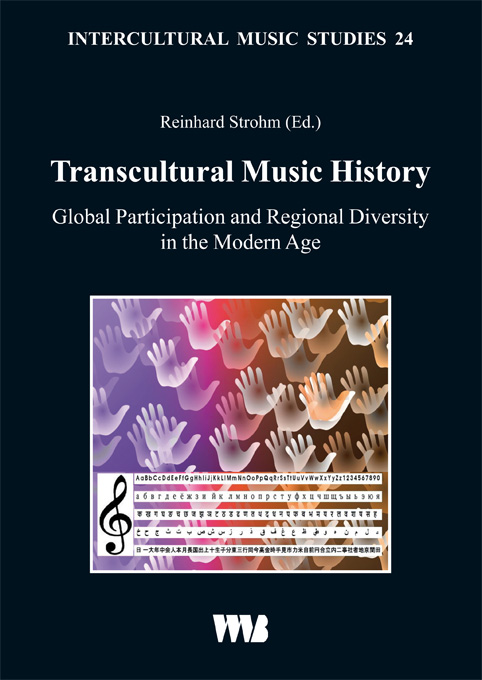
Transcultural Music History. Global Participation and Regional Diversity in the Modern Age Reinhard Strohm (Ed.) (Intercultural Music Studies Vol.: 24) 2021 448 p. + 4 plates numerous figures, photos and musical notations Index 4 color plates 17 x 24 cm hardcover (UVP) EUR 48,00 ISBN 978-3-86135-656-1 This book engages with a transcultural history of music: with musical events, processes and discourses that happened because the world is not compartmentalised in national cultures. The musical experiences reported in these stories, distributed over several continents, were guided by a ′transcultural consciousness′. This means that the historiographers of African music, the practitioners of military music, the proponents of Bach′s music in other continents, the creators and users of sound media, could act as they did because they were conscious of a globalised cultural environment. They participated in wider options but often insisted on their own diversity. A ′global history of music′ (to quote the Balzan Musicology Project from which this volume originates) would be the sum total of musical histories, large and small, around the world. The focus of this book, however, is on musical processes and debates that have in themselves been conditioned by the transcultural consciousness of the modern era. Nineteen specialists of music history, ethnomusicology and cultural studies describe a surprising patchwork of local expertise and global significance. The people who have contributed to this patchwork are innumerable. Contents List of colour plates List of figures List of music examples Index Preface (Reinhard Strohm) Colour plates Introduction Max Peter Baumann: Towards a transcultural music history? The Historiography of African Music Preview Tobias Robert Klein: Panafrica and the idea of (non) absolute music Gerhard Kubik: History, mathematics and auditory perception in African music: A roundtrip through the lecturer’s fieldwork Anna Maria Busse Berger: Ballanta, Trittelvitz and Hagena: A 1920s conversation on church music in Africa Barbara Titus: The West in musical retrospect: The historiographical implications of South African maskanda music Martial and Military Music Traditions Preview Morag Josephine Grant: Chaos and order: Issues in the historiography of martial music Keith Howard: Blowing and hitting: Korean envoys, processionals and martial music Silke Wenzel: Military music in 16th- and early 17th-century Europe: A musical command system between improvisation and denotation Global Views on Bach Preview Thomas A. Cressy: Bach in the early Shōwa-period Japan (1926–1945): Historiography and reception Kayoung Lee: The Bach tercentenary in South Korea (1985): Commemoration, recollection and reflection Daniela Fugellie: Bach and the renewal of Chilean musical life since the 1920s Christina Richter-Ibáñez: Through the lenses of neoclassicism, the Viennese School and exile: An examination of Johann Sebastian Bach in Argentina, 1920 to 1950 Eva Moreda Rodríguez: Bach in Spain and Mexico (1917–1958) through the works of Adolfo Salazar Christin Hoene: Bach (and his absence) in postcolonial Indian literature: The politics of absolute music and genius Media and Transcultural Music History Preview James Kirby: Towards a comparative history of tonal text-setting practices in South East Asia James Mitchell: The Siamese gramophone record industry 1903–1940 in regional context Dariusz Brzostek: Electronic music, socialism and modernity: On remastering the archives of the Polish Radio Experimental Studio Razia Sultanova: The non-Russian sound of post-Soviet Moscow Tom Western: Archival silence: Friction, remediation and purification in online sound archives Bibliography Notes on Contributors
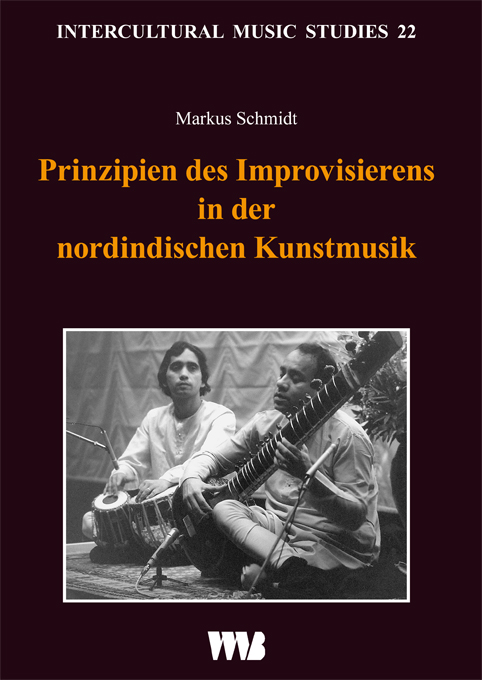
Prinzipien des Improvisierens in der nordindischen Kunstmusik Empirische Untersuchungen der Unterrichts- und Aufführungspraxis Markus Schmidt (Intercultural Music Studies Vol.: 22) 2018 232 S. Buch + 1 Audio-CD zahlr. Notenbeispiele Index 17 x 24 cm EUR 46,00 ISBN 978-3-86135-653-0 Nordindische Kunstmusik gilt als Paradebeispiel improvisierter Musik. Bis zu fünfundneunzig Prozent einer Aufführung seien improvisiert, so ist oftmals von indischen Musikern zu hören. Umso erstaunlicher mutet es an, dass Improvisation in der viele Jahre dauernden klassischen indischen Musikausbildung weder theoretisch noch praktisch eine Rolle spielt. Musikunterricht in Indien folgt dem Prinzip strikter Imitation: der Schüler versucht das, was ihm der Lehrer vorsingt oder -spielt, so exakt wie möglich zu kopieren. Anders ausgedrückt üben indische Musiker über Jahre hinweg vorkomponiertes Material und treten schließlich extensiv improvisierend vor ein Publikum. Um diesen offenkundigen Widerspruch aufzulösen, wendet sich der Autor zunächst den vielfältigen Bedeutungsdimensionen des Improvisationsbegriffs zu und untersucht dessen Anwendbarkeit im Kontext der nordindischen Kunstmusik. Die Tatsache, dass zwischen Unterrichts- und Aufführungspraxis nichts liegt, was für die Ausbildung von Improvisationskompetenz verantwortlich sein könnte, führt ihn zu seiner Leithypothese, der zufolge das Improvisieren in der nordindischen Kunstmusik durch Prinzipien geleitet wird, die durch den Unterrichtsmodus intuitiv angeeignet und in der Aufführungspraxis ebenso intuitiv angewandt werden. Durch die vergleichende Untersuchung von Unterrichts- und Aufführungspraxis gelingt es dem Autor, die zugrundeliegenden Prinzipien des Improvisierens zu isolieren und somit implizites Improvisationswissen zu explizieren. Während sich die Unterrichtsanalyse auf Beispiele aus der wissenschaftlichen Literatur sowie eigene Feldforschungen stützt, basiert die Aufführungsnalyse auf der Transkription einer einstündigen Performance des sitār-Maestros Pandit Subroto Roy Chowdhury und des tablā-Spielers Sanjib Pal. Eine CD mit 6 Audio-Beispielen, 1 Film sowie die Transkription der Performance von Rāga Yaman (pdf – 121 S.) ergänzen diesen Band. Inhalt I. TEXTTEIL Vorwort Anmerkungen zur Transliteration Anmerkungen zur Transkription Einleitung 1. Improvisation – Begriff und Bedeutung 1.1 Autoren 1.1.1 Ernst Ferand 1.1.2 Bruno Nettl 1.1.3 Derek Bailey 1.2 Definitionen 1.3 Etymologische Rekonstruktionen 1.4 Fazit 2. Überblick zur nordindischen Kunstmusik 2.1 Kurze Kulturgeschichte der indischen Kunstmusik 2.2 Zentrale Konzepte: rāga und tāla 2.2.1 rāga – Begriff und Konzept 2.2.1.1 Tonsystem 2.2.1.2 Beispiel rāga Yaman 2.2.2 tāla – Begriff und Konzept 2.2.2.1 Der tihāī 2.3 Konventionen der nordindischen Kunstmusik 2.3.1 Musikalische Stile und Formen 2.3.2 Ensembles 3. Improvisation in der Musikvermittlung 3.1 Das traditionelle Unterrichtssystem 3.1.1 gharānā 3.1.2 guru-śisya-paramparā 3.1.3 tālīm 3.1.4 Das traditionelle Unterrichtssystem im 21. Jahrhundert 3.2 Musikvermittlung in der zeitgenössischen Unterrichtspraxis 3.2.1 Beispiele aus der wissenschaftlichen Literatur 3.2.1.1 Musikvermittlung im Ghulam Ali Khān sarod-gharānā 3.2.1.2 Musikvermittlung im Imdad Khān sitār- und surbāhār-gharānā 3.2.1.3 Musikvermittlung im Dāgar bānī 3.2.1.4 Fazit 3.2.2 Teilnehmende Beobachtung in der Musikethnologie 3.2.2.1 Persönlicher Bezug zur nordindischen Kunstmusik 3.2.3 Musikvermittlung in teilnehmender Beobachtung 3.2.3.1 sitār-Unterricht bei Lalit Gomes 3.2.3.2 rudrā vīnā-Unterricht bei Ashish Sankrityayan 3.2.3.3 sitār-Unterricht bei Subroto Roy Chowdhury 3.2.3.4 Vergleichende Untersuchung des ālāp-Unterrichts 3.3 Fazit 4. Improvisation in der Aufführungspraxis 4.1 Improvisation in der Literatur zur nordindischen Kunstmusik 4.2 Aufführungsanalyse 4.2.1 Methodik 4.2.2 Aufnahme 4.2.3 Aufführungsanalyse rāga Yaman 4.2.3.1 Aufbau 4.2.3.2 Groß-ālāp 4.2.3.2.1 ālāp 4.2.3.2.2 jod 4.2.3.2.3 ālāp-jhālā 4.2.3.3 vilambit gat 4.2.3.3.1 Rhythmische Struktur von Masidkhāni-gat 4.2.3.3.2 Melodische Analyse von Masidkhāni-gat 4.2.3.3.3 Chronologische Analyse vilambit gat 4.2.3.4 drut gat 4.2.3.4.1 drut gat-Strukturen 4.2.3.4.2 Chronologische Analyse drut gat 4.2.3.4.3 gat-jhālā 4.3 Interpretation 4.3.1 Der rāga als Leitprinzip des Improvisierens 4.3.1.1 rāga-Skala 4.3.1.2 Tonhierarchien 4.3.1.2.1 Tonale Zentren 4.3.1.2.2 Stärke, Länge und Behandlung bestimmter Töne 4.3.1.2.3 Fazit 4.3.1.3 Intonations- und Ornamentierungsweisen 4.3.1.4 Charakteristische Phrasen (Melodische Bewegungen) 4.3.1.5 rāga-intrinsische Balance 4.3.1.6 Fazit 4.3.2 Rhythmus und Metrum als Prinzipien des Improvisierens 4.3.2.1 Tempo 4.3.2.2 Rhythmische Gestaltung von Groß-ālāp 4.3.2.3 Rhythmische Gestaltung metrisierter Strukturen 4.3.2.3.1 vilambit gat 4.3.2.3.2 drut gat<7i> 4.3.2.4 Fazit 4.3.3 Gestaltprinzip 4.3.4 Komposition als Prinzip improvisatorische Gestaltung 4.3.5 Ästhetische Prinzipien 4.3.5.1 Prinzip der variierenden Wiederholung 4.3.5.2 Prinzip der Kontrastierung 4.3.5.3 Prinzip des passenden Übergangs 4.3.5.4 Prinzip der Erwartungserzeugung 4.3.5.5 Fazit 5. Konklusion Quellenverzeichnis CD-Inhalt Register II. TRANSKRIPTIONSTEIL Subroto Roy Chowdhury: rāga Yaman: ālāp, jod, jhālā Subroto Roy Chowdhury: rāga Yaman: vilambit gat Subroto Roy Chowdhury: rāga Yaman: drut gat
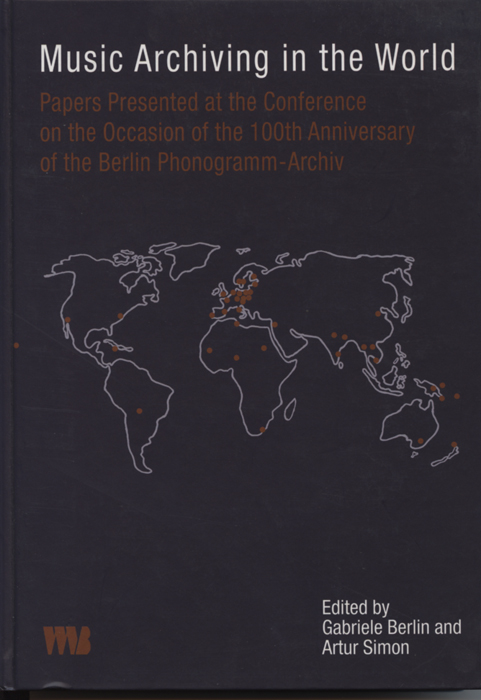
Music Archiving in the World Papers Presented at the Conference on the Occasion of the 100th Anniversary of the Berlin Phonogramm-Archiv Hg./Ed.: Berlin, Gabriele & Simon, Artur 2002 520 p. + Compact Disc Hardcover 17 x 24 cm engl. EUR 50,00 ISBN 3-86135-681-3 This book contains articles by 66 authors who are concerned with the documentation and archival of music and dance. The contributions come from 31 countries from all over the world. In the first section of the book, general recent issues in sound archiving are discussed, such as the significance of archive recordings in modern societies and concepts behind the digitisation of historic sound recordings. The second part gives an insight into the unique qualities of regional and national music archives, not only in industrial metropolises but also in lesser-known places such as Cerreto di Spoleto in the Italian province of Umbria or Port Vila in the South Seas republic of Vanuatu. The articles were presented as papers at the international conference held on the occasion of the 100th anniversary of the Berlin Phonogramm-Archiv in September, 2000, in Berlin, Germany. One of the oldest music archives in existence, the Berlin Phonogramm-Archiv currently contains the largest collections of music and musical instruments in the world. It was here that the scholarly discipline of comparative musicology, or ethnomusicology, originated about one hundred years ago. Because of its unique collections, the archive has been included in the UNESCO "Memory of the World" Register. Inhalt / Contents: Karin von Welck: Message of Greating Klaus-Dieter Lehmann: Greeting Address Viola König: Greeting Address Gabriele Berlin: Preface Dieter Christensen: Berlin Phonogramm-Archiv: The First 100 Years Artur Simon: The Concept of the Berlin Phonogramm-Archiv and the Preservation of Unwritten Music Part I: Recent Issues in Sound Archiving Archive Recordings and Their Significance in Modern Societies Anthony Seeger: Archives as Part of Community Traditions Judith Gray: Performers, Recordists, and Audiences: Archival Responsibilities and Responsiveness Julie To'Liman-Turalir: Why Historic Recordings Are of Value to the Tolai People Today Steven Feld: Sound Recording as Cultural Advocacy: A Brief Case History from Bosavi, Papua New Guinea Märta Ramsten: New Roles for Sound Archives with a Focus on Ethnomisicological Sound Recordings Hans-Hinrich Thedens: Local Archives as a Resource for the Living Folk Music Tradition: Recent Developments in Norway Karaikudi Subramanian: Continuity and Change in Musical Transmission in Contemporary South India: The Case Study of Brhaddhvani Adrienne Kaeppler: The Tahitian Fete of 1937 Revisited in 1979 Tjeerd de Graaf: The Use of Sound Archives in the Study of Endangered Languages Sound Archiving and Technologies Daniel Neumann: Discourse Media 1969/1999 Dietrich Schüller: Audiovisual Sources and Their Future Availability Uwe Umberto Pätzold: Interdisciplinary Aims, Concepts, and Methods of Digital Data Management in Ethnomusicology and the Ethnosciences Pribislav Pitoeff: Computerised Database for an Ethnomusicological Archive: Some Theoretical and Technical Problems and Solutions Chosen by the Laboratoire d'ethnomusicologie du CNRS au Musee de l'Homme (Paris) Clemens Schlenkrich: From Recording-oriented Archiving to Data-oriented Storage: Digitizing of Historical Sound Documents at the Deutsches Rundfunkarchiv Early Recordings on Wax Cylinders and Musical Automata Susanne Ziegler: The Berlin Wax Cylinder Project: Recent Achievement and Aims Gerda Lechleitner: Much More than Sound and Fury! Early Relations between the Phonogram Archives of Berlin and Vienna Franz Lechleitner: Exchanf´ges between the Phonogram Archives in Berlin and Vienna: The Gap between Expectation and Performance in Recording Technologies Don Niles: The Contribution of the Berlin Phonogramm-Archiv to the Study of Papua Newuinea Musics Avi Nahmias: The Restporation of the Lachmann Collection at the National Sound Archives in Jerusalem Piotr Dahlig: Early Field Recordings in Poland (1904-1939) and Their Relations to Phonogram Archives in Vienna and Berlin Razia Sultanova: Early Recordings from Central Asia: A Comparative Study of German and British Collections J. Scott Miller: Accidental Icon: Sadayakko among the Cylinders Gunnar Ternhag: The Introduction of the Phonograph for Documenting Folk Music in Sweden: A Delayed History Helmut Kowar:Musical Automata: Another Source of Information for Ethnomusicology Research Acoustics, Organology, Recordings Albrecht Schneider: On Tonometrical and Sonological Analyses of "Exotic" Instruments: From Stumpf's Measurements to the Present Bozena Muszkalska: Computer Sound Spectrum Analysis as an Aid in the Style Evaluation of a Collection of Portuguese Song in the Berlin Phonogramm-Archiv Manfred Bartmann: Auditory Ambiguity in Xhosa Music: Interactions between Perceptual Complexity, Emic Concepts and Digital Storage Norbert Beyer: From the Archive to India and Back: Organological Questions Answered by Fieldwork Part II: Music Collections in the World AFRICA Bosoma Sheriff, Mai Mallam Kuwuma & Raimund Vogels: Mutuality as a Principle of Musicological Documentation Work in the Borno and Yobe States of Nigeria Ali Al-Daw: TRAMA, The Traditional Music Archive: Its Establishment and Potential Salia Male & Edda Brandes: Musical Heritage, Conservation and Creativity: The Case of the National Museum of Mali Mounir Hentati: Aspects of the Tunisian Experience in the Conservation of Recorded Sound Material ASIA Gert-Matthias Wegner: Nepal: Traditional Music in a Changing World Shubha Chaudhuri: The Challenges of Computerising an Ethnomusicology Archive Ashok D. Ranade: Audio Recording and Oral Tradition in India Gisa Jähnichen: The Archives of Traditional Music in Laos Giovanni Giuriati: The Role of Sound Archives in the Preservation of Living Traditions: Recreation of Khmer Classical Dance-dramas at the National Theatre in Cambodia Khin Maung Tin & Gretel Schwörer-Kohl: Myanmar Sound Archives: A Preliminary Survey Jin Jingyan: The Music Research Institute of the Chinese Academy of Arts OCEANIA Grace koch: Australia's Sound Heritage: Sound Archives in Australia and the Ethical Dimension Richard Moyle: South Pacific Voices Raymond Ammann: The Archive of the Vanuatu Cultural Centre: The Preservation and Maintenance of Melanesian Music AMERICAS Louise Spear: Moving from the Analog to the Digital Millenium: Discovery and Rediscovery Among the Field Recordings in the UCLA Ethnomusicology Archive Rafael Jose Menezes Bastos: Authenticity and Entertainment: Ethnic Folkways Library, american Ethnomusicology and the Ethnic Music Market Wolfgang Bender: Saving the Jamaican Musical Heritage: The Jamaican Folk Music Collection (JFMC) EUROPE Janet Topp Fargion: Living Archives, Commercialisation and the Internet: New Problems for Ethnomusicological Sound Archives Elisabeth den Otter & Rein Spoorman: From Private to Public archive: Sound Recordings in the Royal Tropical Institute of Amsterdam Pia Srinivasan Buonomo: Recording South Indian Music for the Berlin Phonogramm-Archiv Oskar Elschek: Concepts and Strategies of Sound Archives in the Past and Present Ludwik Bielawski: Phonogram Archives and the Documentation of Folk Traditions in Twentieth-Century Poland Auste Nakiene: A Retrospective of the Recording of Folk Melodies in Lithuania Ruta Zarskiene: Archive Recordings of Lithuanian Folk Instrumental Music Jaan Tamm: Contemporary Developments at the Estonian Folklore Archives' Sound Collection Lujza Tari: The History of Phonograph and Digital Sound Recordings and a North Hungarian Village between 1896 and 2000 Vesa Kurkela: Tampere Sound Archive: Saving Old Analog Tapes for Future Generations Salwa El-Shawan Castelo-Branco: Sound as Patrimony: The Plight of Sound Collections in Portugal Silvia Martinez Garcia: A Multimedia Project of the Ethnomusicological Archive of the Departement of Musicology at the Spanish Council for Scientific Research Giancaarlo Palombini & Luciano Giacche: An Ethnomusicological Archive in Umbria (Italy): Probelms and Perspektives of Computerized Management Appendix Table of Musical Examples on the Accompanying CD Index
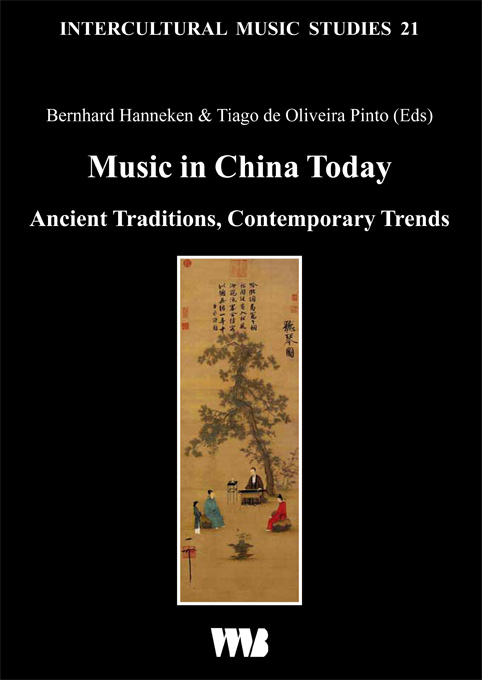
Music in China Today. Ancient Traditions, Contemporary Trends Bernhard Hanneken & Tiago de Oliveira Pinto (Eds) (Intercultural Music Studies Vol.: 21) 2017 256 pp. Book + 1 audio CD numerous Photographs Index engl. + Chinese abstracts 17 x 24 cm EUR 46,00 (UVP) ISBN 978-3-86135-652-3 Given China’s size and its long and varied cultural history with its many different cultural strands (not only from the 55 officially recognized minorities), it is surprising to see that comparatively little has been published in terms of ethno-musicological research. On the other hand, it needed UNESCO’s initiative of the Masterpieces of the Oral and Intangible Heritage of Humanity to remind the Chinese of the values of their own traditions. China participated from the very beginning in the initiative—with success: As of November 2016, China has inscribed almost 30 different traditions into this list, plus another seven into a List of Intangible Cultural Heritage in Need of Urgent Safeguarding. Which has led to a surprising and radical change in the perception of traditional arts and crafts in China itself: All of a sudden they were in high regard again, becoming almost "fashionable pastimes for educated young people" (Helen Rees). This book looks at some of these traditions: at the changing tastes and attitudes towards the guqin zither and at a musical transfer at the end of the 18th century, at the minority music of the Naxi and Uyghur people, at developments in the 20th century such as Li Jinhui’s children operas in the 1920s or at the interdependence between music and power under and after Mao Zedong. Stepping into the 21st century, a new folk song movement and the careers and success of glittering girl bands are examined, as are the ways Chinese in Taiwan look at their old motherland. Two music-related themes are Chinese shadow play and the folk dance genre yangge, and last not least we also can read an advice for westeners how to open their ears for Chinese music. The book comes with an 80-minute audio CD whose 17 tracks give sound to the papers in this publication. Contents Preface ( Bernhard Hanneken & Tiago de Oliveira Pinto ) Helen Rees: Traditional Performing Arts in China Today: Cultural Policy and Practice Barbara Mittler: Of Pride and Prejudice. Rethinking Music and Power in China Alexander Rehding: From [²úªá to Moo-Lee-Chwa. History of a Musical Transfer ca. 1796 Omid Bügin: Representations of Guqin in China Today: From Recurrent Nostalgia, Cultural Etiquette to Revival Movements Frederick Lau: Celestial Music, Glamorous Angels: Girls Glitzing up Traditional Chinese Music Frank Kouwenhoven: Can Chinese Music Swing? NING Er: Soft Knife. China′s Folk Singer/Songwriters in the Last Decade TANG Lijiang: Chinese Shadow Play. Improvisation and Collaboration Johannes Sturm: The Rise and Fall of a Musical Genre: Li Jinhui′s Children Operas in the Context of Time Yongfei DU: Yangge: A Genre of Chinese Folk Dance Chuen-Fung WONG: Intercultural Encounters, Global Circulations, and the "Original Ecology" Style of Uyghur Music in the Late Twentieth Century and Beyond CHUNG Shefong: Who Is Singing Over Here? China as Ancestors′ Home and as a Foreign Land The Authors Content of CD Index
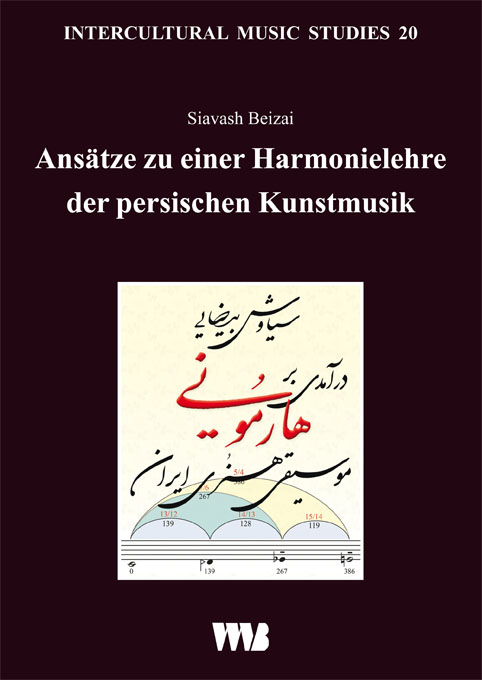
Ansätze zu einer Harmonielehre der persischen Kunstmusik Siavash Beizai (Intercultural Music Studies Vol.: 20) 2016 248 S. Buch + 1 CD zahlr. Notenbeispiele Index engl., pers. + dt. Zusammenfasung 17 x 24 cm EUR 42,00 ISBN 978-3-86135-651-6 Diese Publikation befasst sich zum ersten Mal mit der Geschichte, Theorie und Praxis der Mehrstimmigkeit der persischen Kunstmusik, in der seit Mitte des 19. Jahrhunderts durch die ersten Kontakte mit der europääischen Musikkultur eine neue Epoche eingeleitet wurde. Es werden die Grundlagen und allgemeinen Regeln einer Harmonielehre der persischen Kunstmusik dargelegt, die großenteils aus Modi mit vierteltönigen Intervallen besteht. Die Intervalle, Akkorde, ihre Notationen und Terminologien, die modalen Strukturen und die wichtigen Aspekte des Tonsatzes werden ausführlich besprochen und durch konkrete Beispiele veranschaulicht. Anhand zahlreicher Noten- und Audiobeispiele sowie Analysen kann der Leser nicht nur das Modalsystem der persischen Musik kennen lernen, sondern auch die geschichtlichen Entwicklungsphasen der Mehrstimmigkeit der persischen Kunstmusik näher betrachten. Aus dem reichen Forschungs- und Erfahrungsschatz des Komponisten und Hochschullehrers Siavash Beizai heraus geschrieben, dient das Buch Musikwissenschaftlern, Komponisten, Musikstudenten und darüber hinaus auch Studenten, Musikern und Musikliebhabern als Referenz, Anregung und Wegweiser zur persischen Musik und ihrer Mehrstimmigkeit. (Zusammenfassung in deutscher, englischer und persischer >Sprache). Siavash Beizai, geb. 1953 im Iran, absolvierte sein umfangreiches Musikstudiumban der Hochschule für Musik Detmold (Komposition und Tonmeister), Folkwang-Hochschule Essen (Elektronische Komposition) und Wilhelms-Universität Würzburg (Promotion Musikwissenschaft). Er schlägt neue Wege in die Mehrstimmigkeit der persischen Musik ein und war u. a. jahrelang Dozent für Musiktheorie und Komposition an der Kunstuniversität und Hochschule für Musik in Teheran. Als Komponist und Autor sind von ihm bereits zahlreiche Werke ver&oouml;ffentlicht worden. Nähere Infos: www.siavash-beizai.com Inhalt Die wichtigsten Fachbegriffe der gegenwärtigen persischen Kunstmusik Vorwort I. Stand der Forschung und die Vorgeschichte der Mehrstimmigkeit der persischen Kunstmusik II. Notation der persischen Musik sowie charakteristische Intervalle und Akkorde 2.1 Zur Notation der persischen Musik 2.2 Charakteristische Intervalle der persischen Musik 2.3 Charakteristische Akkorde der persischen Musik III. Das Modalsystem der persischen Musik 3.1 Verschiedene Versionen des radif 3.2 Dastgah als Hauptmodus der persischen Kunstmusik 3.3 Avaz als untergeordneter Modus des dastgah 3.4 Guše, die melodisch-modale Einheit der radif 3.5 Die charakteristischen Eigenschaften der guše 3.5.1 Verschiede Arten der guše 3.5.2 Die Merkmale einer guše 3.6 Die dastgahs und avaze im Einzelnen 3.6.1 Dastgah-e mahur 3.6.2 Dastgah-e šur 3.6.3 Avaz-e abu‘ata 3.6.4 Avaz-e bayat-e tork (bayat-e zand) 3.6.5 Avaz-e afšari 3.6.6 Avaz-e dašti 3.6.7 Dastgah-e nava 3.6.8 Dastgah-e homayun 3.6.9 Avaz-e esfehan 3.6.10 Dastgah-e segah 3.6.11 Dastgah-e cahargah 3.6.12 Dastgah-e rast-panggah 3.7 Die vierteltönigen Intervalle der persischen Musik 3.8 Zur Größe der dreivierteltönigen Intervalle der persischen Musik 3.9 Die temperierten Vierteltöne und die 24-stufige Vierteltonleiter 3.10 Die neuen Möglichkeiten der Dreivierteltöne 3.11 Zur Konsonanz der dreivierteltönigen Intervalle und Akkorde 3.12 Die Leittöne der persischen Musik IV. Harmonielehre der persischen Kunstmusik 4.1 Zur Geschichte des harmonischen Denkens in der persischen Kunstmusik 4.2 Kontroverse Konzepte zur Praxis der Harmonisierung in der persischen Kunstmusik 4.3 Verschiedene Möglichkeiten, die persische Musik zu harmonisieren 4.4 Untersuchung der Harmonie in der traditionellen radif der persischen Kunstmusik 4.4.1 Dastgah-e mahur und rast-panggah 4.4.2 Dastgah-e šur und die verwandten avaze 4.4.3 Dastgah-e nava 4.4.4 Dastgah-e segah 4.4.5 Dastgah-e homayun 4.4.6 Avaz-e esfehan 4.4.7 Dastgah-e cahargah 4.5 Zu allgemeinen Regeln einer Harmonielehre der persischen Kunstmusik 4.5.1 Aufbau der Harmonielehre 4.5.2 Zur Stimmführung und Verdopplung der Töne 4.5.3 Die Grundakkorde der persischen Modi 4.6 Harmonisierungsmodelle der persischen Modi im Einzelnen 4.6.1 Dastgah-e mahur und rast-panggah 4.6.2 Dastgah-e šur und die verwandten avaze 4.6.2.1 Die Kadenzen des šur-Modus 4.6.2.2 Avaz-e abu‘ata 4.6.2.3 Avaz-e afšari 4.6.2.4 Avaz-e bayat-e tork 4.6.2.5 Avaz-e dašti 4.6.3 Dastgah-e nava 4.6.4 Dastgah-e homayun 4.6.5 Avaz-e esfehan 4.6.6 Dastgah-e cahargah 4.6.7 Dastgah-e segah V. Ansätze zu einer Harmonielehre der persischen Kunstmusik. Zusammenfassung Approches to the Harmony of Persian Art Music. Abstract VI. Liste der Hörbeispiele der beiliegenden CD-ROM VII. Diskografie VIII. Noten und Partituren IX. Literatur- und Quellenverzeichnis X. Namens- und Sachregister
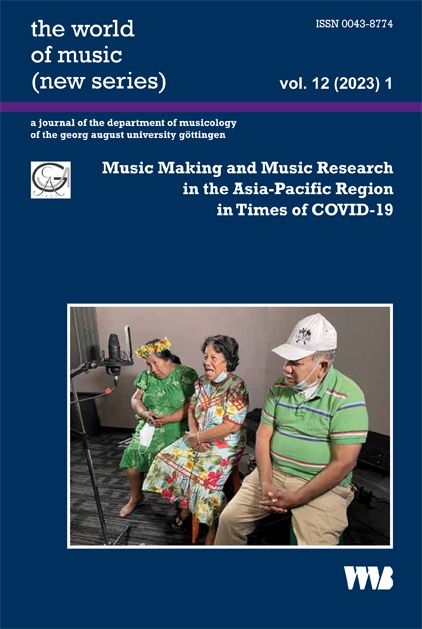
Music Making and Music Research in the Asia-Pacific Region in Times of COVID-19 World of Music vol. 12 (2023) 1, ISSN 0043-8774 ISBN 978-3-86135-934-0 Subscription information: Language of publication: English Bibliography: 2 issues per year —published in June and December 15,2 x 22,8 cm ISSN 0043-8774 Prices: single issue (plus shipping): (UVP) EUR 38,00 double issue (plus shipping): (UVP) EUR 55,00 (prices single and double issue plus postage and handling) annual subscription in Germany: (UVP) EUR 70,00 annual subscription abroad: (UVP) EUR 84,00 (subscription prices include postage and handling) Shipment to abonees done - new subscriptions open 2023, 2024, 2025 For subscription or international orders send inquiry per email. Content: Sebastian Hachmeyer & Celia Fritze-Nabjinsky, Introduction: Surmounting Physical Distance Muhammad As‘ad, Dadi Darmadi, and Anne K. Rasmussen, Islamic Music and Qur’anic Arts in the Time of the Corona Pandemic: Collaborative Research and Virtual Ethnography “in” Indonesia Trisnasari Fraser, Jane W. Davidson, and Alexander Hew Dale Crooke, Intercultural Music Engagement over Electronic Bridges: Online Ethnography and Actions Research during COVID-19 Lockdown Jessica Schwartz, “Music as Method” in Marshallese Communitydriven Research & Outreach during the COVID-19 Pandemic Andrew Gumataotao, Fieldwork through Filmmaking: Listening to Narrative Medicine in “Tåhdong Marianas” William Donnie Scally, Music and Sound in Toyama City Up-close and from Afar: A Close Reading of Online Materials Informed by In-person Experience
Das Berliner Phonogramm-Archiv 1900-2000 Sammlungen der traditionellen Musik der Welt The Berlin Phonogram Archive 1900-2000 Collection of Traditional Music of the World Hg./Ed.: Simon, Artur 2000 240 S./p. Hardcover 17 x 24 cm zweisprachlich/bilingual: dt. + engl. EUR 39,00 ISBN 978-3-86135-680-6 Inhalt / Contents: György Ligety: Grußwort / Greeting address Artur Simon: Einleitung / Introduction Farbtafeln I-VIII / Color Plates I-VIII E.M. v. Hornbostel & A. Simon: Geschichte des Phonogramm-Archives (1900-2000) / History of the Phonogramm-Archiv (1900-2000) Artur Simon: Die musikalischen Traditionen der Menschheit im Berliner Phonogramm-Archiv 1900-2000. Sammeln, Bewahren, Forschen und Vermitteln / The Musical Traditions of Mankind in the Berlin Phonogramm-Archiv 1900-2000. Collecting, Preserving, Researching and Communicating Carl Stumpf: Das Berliner Phonogrammarchiv / The Berlin Phonogrammarchiv Erich M. v. Hornbostel: Über den gegenwä,rtigen Stand der vergleichenden Musikwissenschaft / On the Current State of Comparative Musicology Erich M. v. Hornbostel: Die Erhaltung ungeschriebener Musik / The Preservation of Unwritten Music Erich M. v. Hornbostel: Phonogramm-Archiv des Psychologischen Instituts der Universität, Berlin C.2, Schloss / Phonogramm-Archiv of the Psychological Institute of the University, Berlin C2, Schloß (Castle) Erich M. v. Hornbostel: Demonstrations-Sammlung / Demonstration Collection Carl Stumpf: Antrag an S. Excellenz den Minister für Wissenschaft, Kunst und Volksbildung / Applikation to the Minister of Science, Art and Popular Education Curt Sachs & Erich M. v. Hornbostel: Denkschrift über die Vereinigung der Sammlung alter Musikinstrumente mit dem Phonogrammarchiv beim Psychologischen Institut zu einem Staatlichen Museum der Tonkunst / Memorandum on the Amalgamation of the Collection of Old Musical Instruments with the Phonogrammarchiv at the Psychological Institute into a Staatliches Museum der Tonkunst Erich M. v. Hornbostel: Carl Stumpf und die Vergleichende Musikwissenschaft (Zum 21. April 1933) / Carl Stumpf and Comparative Musicology (On the 21st of April 1933) Jaap Kunst: Zum Tode Erich von Hornbostel's / On the Death of Erich von Hornbostel Marius Schneider: Das Phonogramm-Archiv des Museum für Völkerkunde / The Phonogramm-Archiv of the Museum of Ethnography Kurt Reinhard: Zwanzig Jahre Wiederaufbau des Berliner Phonogramm-Archivs / Twenty Years of Rebuilding the Berlin Phonogramm-Archiv Dieter Christensen: Erich M. v. Hornbostel, Carl Stumpf und die Institutionalisierung der Vergleichenden Musikwissenschaft / Erich M. von Hornbostel, Carl Stumpf and the Institutionalization of Comparative Musicology Sammlungen, Forschungsberichte und Projekte / Collections, Research Reports and Projects Andreas Meyer: Die Musikinstrumentensammlung des Berliner Phonogramm-Archivs / The Berlin Phonogramm-Archiv's Collection of Musical Instruments Kurt Reinhard: Eine weitere ethnomusikologische Studienreise in die Türkei 1972 / One More Ethnomusicological Study Trip to Turkey Artur Simon: Feldforschungen in Ägypten und dem Sudan 1972-1974 / Field Research in Egypt and the Sudan 1972-1974 Artur Simon: Die Musikethnnnnnologie im interdisziplinären Schwerpunktprogramm der Deutschen Forschungsgemeinschaft "Mensch, Kultur und Umwelt im zentralen Bergland von West-Neuguinea" 1975-1976 / Ethnomusicology in the Interdisciplinary Programme of the Deutsche Forschungsgemeinschaft "Humanity, Culture and Environment in the Central Highlands of Western New Guinea" 1975-1976 Artur Simon: Eine Filmdokumention sozialer und religiöser Zeremonioen und von Zeremonialmusik der Batak in Nord-Sumatra, Indonesien 1981 / A Film Documentation of Social and Religious Ceremonies and Ceremonial Music of the Batak in Northern Sumatra, Indonesia (1981) Raimund Vogels: Das "Borno Music Documentation Project" (B.M.D.P.) in Nigeria / B.M.D.P. - The "Borneo Music Documentaton Project" in Nigeria Ulrich Wegner: "MusikWeltKarte". Eine Hypermedia-Installation / MusikWeltKarte ('MusiccWolrdMap') - A Hypermedia Installation Susanne Ziegler: Das Walzenprojekt zur Rettung der größten Sammlung alter Klangdokumente von traditioneller Musik aus aller Welt. Walzen und Schellackplatten des Berliner Phonogramm-Archivs / The Wax Cylinder Project in Rescue of the Largest Collection of Old Sound Documents of Traditional Music from Around the World. Wax Cylinders and Shellac Records of the Berlin Phonogramm-Archiv Albrecht Wiedmann: Einige technische Bemerkungen zur digitalen Konservierung der alten Bestände des Berliner Phonogramm-Archivs / A Few Technical Remarks on the Digital Conservation of the Old Inventory of the Berlin Phonogramm-Archiv Gerd Stanke & Thomas Keßler: Verfahren zur Gewinnung von Tonsignalen aus Negativ-Spuren in Kupfernegativen von Edison-Zylindern auf bildanalytischem/sensoriellen Wege (SPUBITO) / Procedure to Recover Sound Signals from the Negative Tracks in Copper Megatives of Edison Cylinders in an Image Analysis/Sensorial Way (SPUBITO) Anhang / Appendix
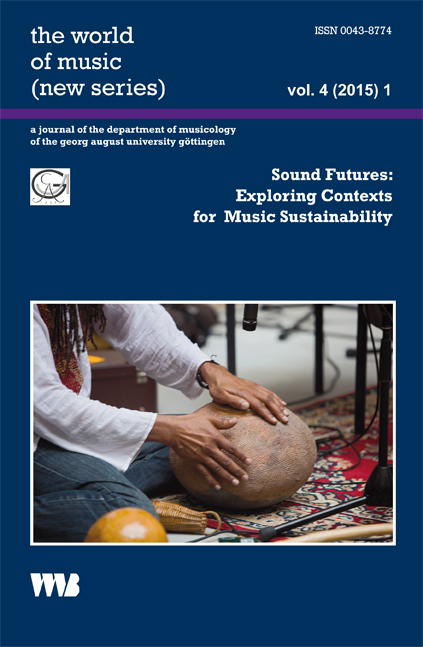
Sound Futures: Exploring Contexts for Music Sustainability Guest Editors: Dan Bendrups & Huib Schippers the world of music (new series)Vol. 4(2015) 1 2015 146 p. fig., photos and musical notations (UVP) EUR 36,00 - EINZELEXEMPLAR ganz leichte Bestoßen an Kante vom Cover - 28 EUR Sonderpreis ISBN 978-3-86135-910-4 Contents: Articles Dan Bendrups & Huib Schippers: Preface: Sound Futures Huib Schippers & Dan Bendrups: Ethnomusicology, Ecology and the Sustainability of Music Cultures Anthony Seeger & Shubha Chaudhuri: The Contributions of Reconfigured Audiovisual Archives to Sustaining Traditions Trevor Wiggins: Music, Education, and Sustainability Zhang Boyu, with Yao Hui & Huib Schippers: Report: The Rise and Implementation of Intangible Cultural Heritage Protection for Music in China Dan Bendrups & Donna Weston: Open Air Music Festivals and the Environment: A Framework for Understanding Ecological Engagement Alison Booth: Producing Bollywood: Entrepreneurs and Sustainable Production Networks Richard Letts. Global Perspectives: The IMC Report on Forces Affecting Music Sustainability Book Reviews (Eva-Maria van Straaten, ed.) Carl Clements: Martin Clayton, Byron Dueck, & Laura Leante (eds.), Experience and Meaning in Music Performance (2013) Louis Regis: Jocelyne Guilbault & Roy Cape, Roy Cape, A Life on the Calypso and Soca Bandstand (2014) Tom Solomon: Philip V. Bohlman (ed.), The Cambridge History of World Music (2013) Eckehard Pistrick: Andreas Gebesmair, Anja Brunner & Regina Sperlich (eds.), Balkanboom! Eine Geschichte der Balkanmusik in Österreich (2014) Anna-Elena Pääkkölä: Babette Babich, The Hallelujah Effect—Philosophical Reflections on Music, Performance Practice, and Technology (2013) Maria S. Guarino: Ian Russell & Catherine Ingram (eds.), Taking Part in Music: Case Studies in Ethnomusicology (2013) Stefan Fiol: Andrew Alter, Mountainous Sound Spaces: Listening to History and Music in the Uttarakhand Himalayas (2014) Stig-Magnus Thorsen: David A. McDonald, My Voice Is My Weapon: Music, Nationalism, and the Poetics of Palestinian Resistance (2013) Recording Reviews ((Robert Fry, ed.) David Knapp: Nudbok al Amar (Dabke on the Moon), DAM. Produced by Nabil Nafar, Jethro Beats, Anan Ksym, and Abed Hathut (2012) Jacqueline Avila: Birdman (Or The Unexpected Virtue of Ignorance). Original Motion Picture Soundtrack. Prodcued by Alejandro Gonzalez Iñárritu (2014) Kayleen Justus: Oui ma Cherie!—Music for Steel Orchestra, Studio Kitchen Crew. Produced by Andy Narell (2014) Lisa Osunleti Beckley-Roberts: Hunter Poetry, WolfHawkJaguar. Produced by Wolfhawkjaguar (2012) the world of music (new series) About the Contributors
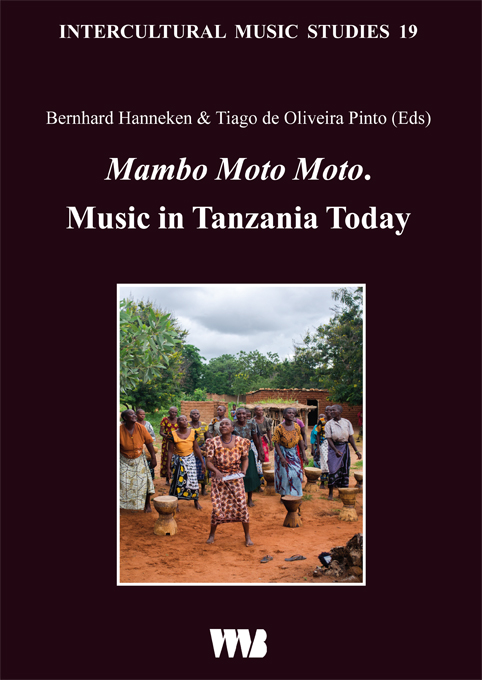
2016 232 pp. Book + 1 DVD numerous Photographs + 8 pp. color plates Index engl. + German abstract 17 x 24 cm EUR 38,00 (UVP) ISBN 978-3-86135-650-9 Looking at the music of present-day Tanzania opens a broad range of perspectives on a multitude of forms of expressions that require a particularly large pluralism of methods. As cooperation und locally added value are no longer blocked out of international musical and cultural activities, the question must be raised how a contemporary musicology may be shaped under these new pretexts. The papers in this volume are vivid proof that also social, historic, commercial, political and other connotations are of interest. Mambo Moto Motoy means something like "hot stuff"—a description that is certainly not amiss when talking about the traditional and contemporary music of Tanzania. The ten contributions deal with musical culture and practise in Tanzania, from the vocal polyphony of the Wagogo women (Gerhard Kubik, Philip Küppers & Kedmon Mapana) to traditional and religious music on Zanzibar and along the Swahili coast (Hildegard Kiel, Aisha Othman), from urban trends (Kelly Askew, Werner Graebner) to the music of the quartet Wamwiduka as an example for transcultural musical processes (Tiago de Oliveira Pinto), and from questions of cultural education (Mitchel Strumpf, Kedmon Mapana) to practical aspects of preserving the treasures of Radio Tanzania (David Tinning). These deeply interesting texts offer a view on music in Tanzania that goes far beyond conventional volumes in musicology as it includes research, inventory, didactic aspects and presentations of projects in equal measure. A 80-minute DVD contains the film With the Drums in their Luggage about the journey of the Ufunuo Muheme Group from their home village in Central Tanzania to Rudolstadt and Weimar in Germany in July 2014. The disc also includes live footage from the bands Dogo Dogo Stars, Jagwa Music, Segere Original, and Wamwiduka. Contents Vorwort Tiago de Oliveira Pinto:Vorwort / Preface Tiago de Oliveira Pinto: African Music in and out of Africa. A Transcultural Approach Gerhard Kubik: The Gogo Tonal-Harmonic System Philipp Küppers & Kedmon E. Mapana: Ng’oma in Chamwino Kelly Askew: Neosocialist Moralities versus Neoliberal Religiousities. Constructing Musical Publics in 21st Century Tanzania Werner Graebner: Other Flavas from Bongo: Mchiriku, Segere & Baikoko—A Look at Alternative Musical Expression in Dar es Salaam Hildegard Kiel: Love, Grief and the Sea Aisha Othman: Maulidi Ceremonies in Zanzibar Mitchell Strumpf: Different Approaches to Music Education in East Africa. The Past Hundred Years Kedmon E. Mapana: Arts in Education. What Do Tanzanians Need to Know? David Tinning: Reviving the Radio Tanzania Archives The Authors Index DVD Mambo Moto Moto at TFF Rudolstadt 2014

Access to Waxes – The Collections from the Arab World of the Berlin Phonogramm-Archiv Ithe world of music (new series) vol. 12 (2023) 2ISSN 0043-8774ISBN 978-3-86135-935-7Subscription information:Language of publication: EnglishBibliography:2 issues per year —published in June and December15,2 x 22,8 cmISSN 0043-8774Prices:single issue (plus shipping): (UVP) EUR 36,00double issue (plus shipping): (UVP) EUR 55,00(prices single and double issue plus postage and handling)annual subscription in Germany: (UVP) EUR 70,00annual subscription abroad: (UVP) EUR 84,00(subscription prices include postage and handling) Issue in production - expected delivery, begin of octoberFor subscription or international orders send inquiry per email. Issues 2024 available soon, subscription 2024 and 2025 open - ask for updated prices. Content:Nadia Bahra, Lando Kirchmair, Matthias Pasdzierny, andAlbrecht Wiedmann, Access to Waxes – The Collections fromthe Arab World of the Berlin Phonogramm-Archiv: BetweenDigitization, "Repatriation," and Online PublicationSalwa El-Shawan Castelo-Branco, Interrogating "Access toWaxes" – Introductory Remarks on the Collections from the ArabWorld of the Berlin Phonogramm-ArchivSusanne Ziegler, The Collections of Music from the Arab World inthe Berlin Phonogramm-ArchivJean Lambert, A Historical Glimpse of Music in Yemen in the1930s: A First Approach to the Cylinders Recorded by HansHelfritzMatthias Pasdzierny, Whom to Remember – How to Return?Brigitte Schiffer, the Voices of Siwa and the Entangled History ofthe Berlin School of EthnomusicologyRuth F. Davis, From Wax Cylinder to Metal Disc: TransplantingRobert Lachmann’s “Oriental Music” Project from Berlin toJerusalem on the Eve of World War II
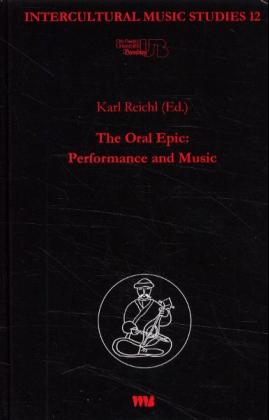
2000 256 S./p. Hc 13,5 x 21 cm engl. (UVP): EUR 34,00 ISBN 978-3-86135-643-1 There is plenty of evidence that both in ancient Greece and in medieval Europe orally performed epics were sung rather than spoken, often to the accompaniment of a musical instrument. Although scholars studying epics such as the Iliad, the Odyssey or the Chanson de Roland have commented on this fact, little progress has been made in incorporating the musical and more generally the performative aspect of oral epic into their interpretations. This is partly explained by the scarcity of musical documents that have come down to us. There is, however, a wealth of comparative material from living traditions and the implications of their study for traditional medieval epics (and possibly also the Homeric poems) form the subject of this book. This book is the first representative survey of the music and performance of oral epic poetry world-wide. It contains a general introduction on the music and performance of oral epics by Karl Reichl (University of Bonn). Contents: Preface Karl Reichl: Introduction: The Music and Performance of Oral Epics Gregory Nagy: Epic as Music: Rhapsodic Models of Homer in Plato's Timaeus and Critias Stephen Erdely: Music of South Slavic Epics Wolf Dietrich: The Singing of Albanian Heroic Poetry Margaret H. Beissinger: Creativity in Performance: Words and Music in Balkan and Old French Epic Dzhamilya Kurbanova: The Singing Traditions of Turkmen epic Poetry Karl Reichl: The Performance of the Karakalpak Zhyrau Emine Gürsoy-Naskali: Dudak degmez: A Form of Poetry Competition among the Asiks of Anatolia Hiromi Lorraine Sakata: The Musical Curtain: Music as a Structural Marker in Epic Performance Carole Pegg: The Power of Performance: West Mongolian Heroic Epics Nicole Revel: Singing Epics among the Palawan Highlanders (Philippines): Musical and Vocal Styles Christiane Seydou: Word and Msuic: The Epic Genre of the Fulbe of Massina (Mali) Joseph Harris: The Performance of Old Norse Eddic Poetry: A Retrospective John Stevens: Reflections on the Music of Medieval Narrative Poetry
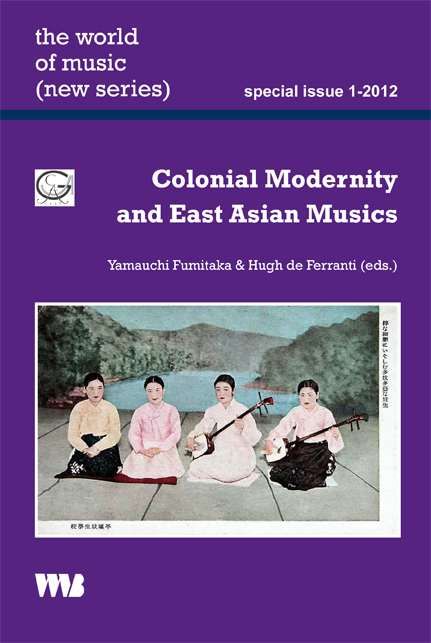
Colonial Modernity and East Asian Musics Hugh de Ferranti & Yamauchi Fumitaka (eds.) (the world of music (new series) special issue Vol. 1-2012) 2012 208 p. fig., photos and musical notations (UVP) EUR 32,00 ISBN 978-3-86135-930-2 This special issue includes contributions by prominent music researchers based in China, Japan, Taiwan, and Australia. One of the first attempts to present scholarly work on music in colonial era East Asia in a thematically coordinated manner, the issue delineates diverse experiences of colonialism and modernity among musicians in Korea, Taiwan, Japanese-occupied Shanghai, and naichi or ‘home islands’ Japan. A study of musical interface between French colonists and Vietnamese in prewar Hanoi offers a comparative perspective on music and colonial modernity in what had formerly been part of the cultural Sinosphere. Contents: Articles Preface Hugh de Ferranti & Yamauchi Fumitaka: Introduction Wang Ying-fen: Zhang Fuxing’s Musical Negotiation between Tradition and Modernity in Colonial Taiwan Tang Yating : Japanese Musicians in the Shanghai Municipal Orchestra (^1942–45) Michael E. McClellan: Making Music Modern: Colonial Hanoi and the Politics of Sound Philip Flavin: Echoes and Images of Colonial Japan: Imperialism and Modern Music for the Koto Yamauchi Fumitaka: (Dis)Connecting the Empire: Colonial Modernity, Recording Culture, and Japan-Korea Musical Relations About the Authors

Articles: Jacob Olley, Resounding 1923: Musical Modernities from the Ottoman Empire to the Turkish Republic Panagiotis C. Poulos, “Foreigners in their Homeland”: Song Writing, Musical Estrangement, and Subjecthood Formation in Late Ottoman Istanbul Jacob Olley, Joking Aside: European Music and the Dislocation of Modernity in Nineteenth-Century Ottoman SatirehBurcu Yıldız, Transcultural Memory in the Study of Folk Music in Turkey: 78-rpm Records of the Ottoman American Diaspora Onur Günes ¸ Ayas, Self-Orientalist Representations of Turkish Classical Music in the Republican Era: Orientalism and Orientalism in Reverse Evrim Hikmet Ög˘ üt , Rauf Yekta’s Notes on the 1932 Congress of Arab Music: Being a Mediator in a Dual Musical Universe Elif Damla Yavuz, Institutionalizing Opera in Turkey: Carl Ebert and the Opera Studio Erol Köymen, Provincializing Acoustics, Feeling Europe: Heritage and Sonic Atmosphere in Istanbul Martin Stokes, Afterword: Istanbul, Cairo, and the “Demography of Babel”
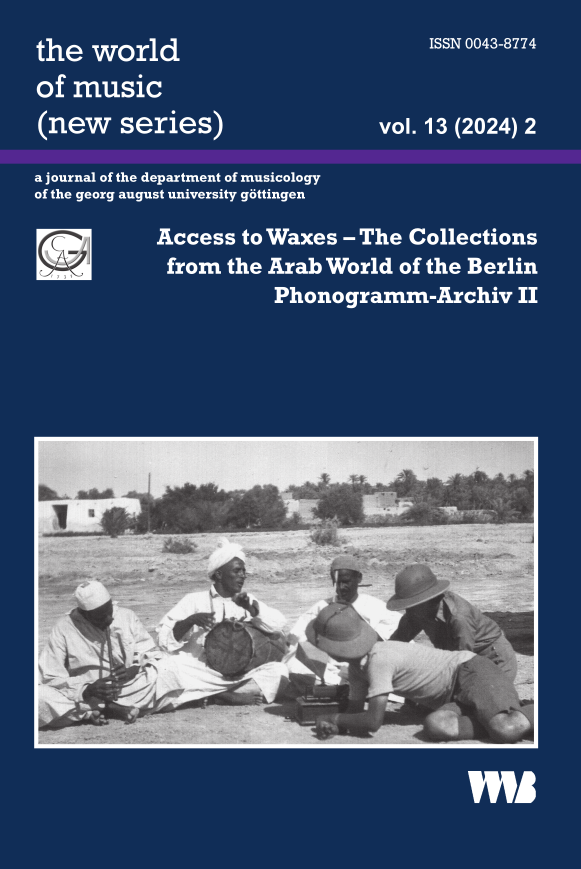
World of Music vol. 13 (2024) 2, Access to Waxes – The Collections from the Arab World of the Berlin Phonogramm-Archiv II ISSN 0043-8774 ISBN 978-3-86135-938-8 Content / articles: Dörte Schmidt, Data Diplomacy: "Access to Waxes" and the Need for Negotiating Spaces Souheir I. Nadde, The Berlin Phonogramm-Archiv Collections: Legal framework from Arab Countries PerspectivehhChristian Czychowski, Lea Riechers, Copyright issues: Sound Recordings from German Prisoner of War Camps of World War I and World War II Lando Kirchmair, Open Access Publication of the Historical Sound Recordings of the Berlin Phonogramm-Archiv: Arguments from Public International Law and Cultural Ethics Mèhèza Kalibani, Prolegomena to the Study of Historical Sound Recordings from Colonial Contexts
